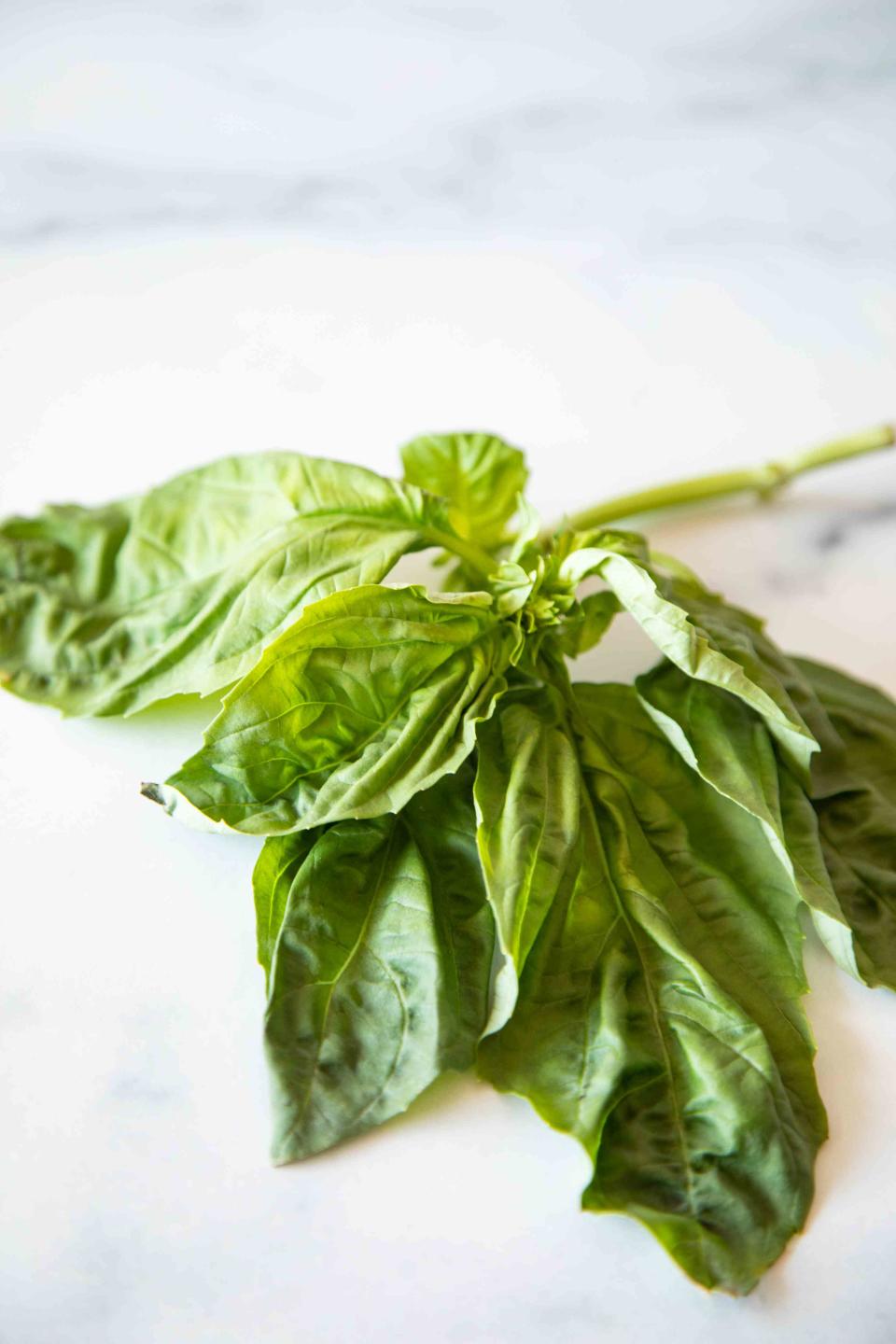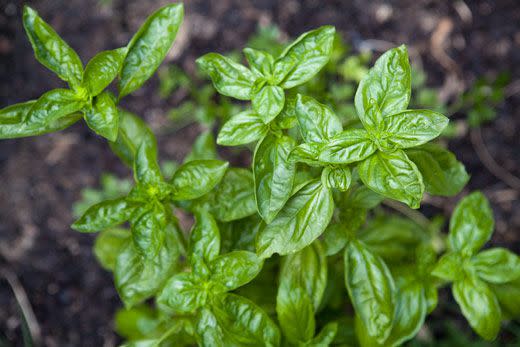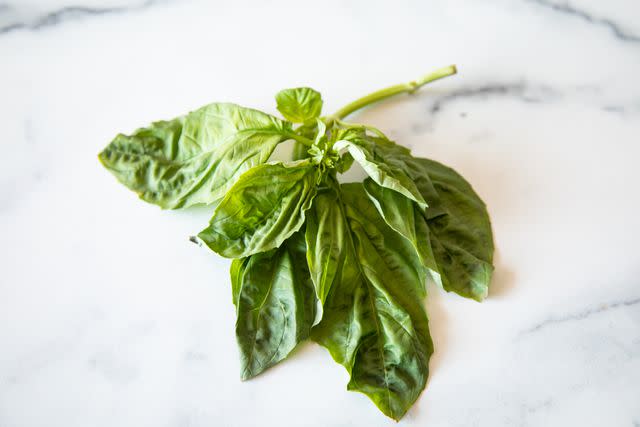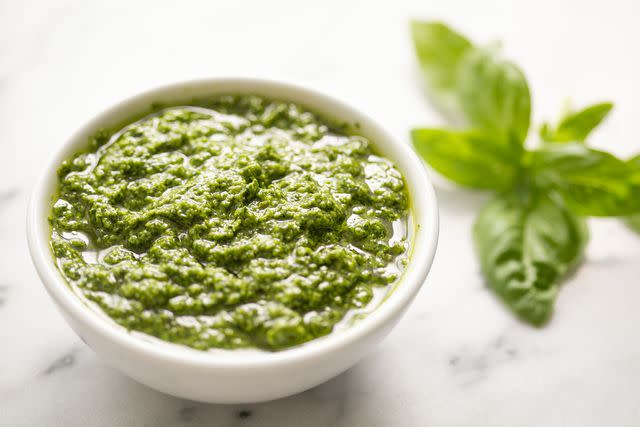What Is Basil?
Everyone loves basil in pesto or Caprese salad, but there are so many more ways to make great use of this bright, versatile herb. Learn how to buy, store, and cook with basil.

Simply Recipes / Lori Rice
If you’re looking to start an herb garden and need an ego boost, plant some basil. This versatile herb is so prolific that a search around the internet will yield plenty of recipe collections for an abundance of basil.
Whether you buy basil at the store or grow it yourself, read on for everything you need to know about the bright green herb.

Simply Recipes / Elise Bauer
Varieties of Basil
Basil aficionados know that there’s sweet basil, which is the variety most often found in U.S. grocery stores, and there’s Thai basil, commonly used in Southeast Asian cuisine. But that’s just the beginning. There are actually over 60 varieties of basil, each with a slightly different flavor. Examples include cinnamon, purple, and holy—which is typically used in herbal medicine. Here are the three most common varieties:
Sweet basil: The variety of sweet basil that’s easiest to find in the U.S. is typically Genovese basil. It grows large, green leaves and is great for making pesto. You may also find Neapolitan basil—the two can be used interchangeably.
Thai basil: It's recognizable for its anise-like flavor and smaller, sturdier leaves. This type of basil is great in stir-fries and atop Southeast Asian curries.
Lemon basil: Another variety you’ll come across at plant nurseries is lemon basil. As its name suggests, lemon basil has a bright, lemony flavor. Use it in Thai, Indonesian, or Vietnamese dishes as well as cocktails.
Dried vs. Fresh Basil
Because of the vibrant, fresh flavor that basil adds to dishes, we prefer fresh basil and only recommend dried in a pinch (pun intended). Dried basil just doesn’t have the same flavor; it’s milder and misses those multi-dimensional herbal notes.
If you must use it, a good rule of thumb is to substitute 1/3 the amount of dried basil for fresh basil.
Read More:How to Dry Herbs

Simply Recipes / Lori Rice
Where to Buy and How to Store
Sweet Genovese basil is easy to find in the produce aisle of most grocery stores. For Thai or lemon basil, look in Asian markets, nurseries, or online. For harder-to-find varieties like cinnamon or purple basil, searching online or asking your local nursery is probably the best bet.
Store fresh, cut basil in a jar of water covered with a plastic bag at room temperature—not the refrigerator. Basil leaves are so delicate that they do better out of the fridge. Once the leaves wilt, you can still use them in cooked applications. Once they’ve wilted and turned brown, it’s time to throw them out.
Read More:How to Store Parsley, Cilantro, and Other Fresh Herbs
If you plan to use basil in sauces or soups, including pesto, you can freeze blanched whole leaves in plastic wrap. To blanch, dunk the fresh leaves in boiling water until wilted, about 30 seconds. Transfer to an ice bath, then squeeze dry. Frozen leaves are not good for raw applications like salads and garnishing dishes.
You can also freeze portions of pesto in ice cube trays if you’re a real pesto lover who won’t get through the winter without it. Once frozen, pop out the pesto and store in a zip-top freezer bag for up to a month. Drop the cubes into soup, into a pan with pasta, and more.
Basil Substitutes
Because of its distinct flavor, basil is a hard herb to substitute for. You can’t just go swapping sweet basil for Thai or lemon basil, either. The best bet is to consider your recipe first:
If you’re subbing sweet basil in pesto: Use leafy greens such as spinach or kale, or a mix of greens and some herbs, like parsley and mint.
If you’re subbing basil in a pasta dish or sauce: Use fresh oregano instead.
If you’re subbing basil in a cocktail: Consider mint!
If you’re subbing lemon basil in a dish: Use another leafy green and add in some lemon zest. Or, even better, use lemon verbena.
If you’re subbing Thai basil in a dish: Think about whether sweet basil will work instead. If not, try some fresh mint or cilantro.
How to Cook with Basil
Like most fresh herbs, basil is the most fragrant and adds the most to a dish when it is added at the end of cooking or just before serving. However, in certain applications, like tomato sauce, a few torn leaves can add a bedrock of Italian flavor.
Remove basil leaves from their stalks by tearing them off with your hands, and either continue to tear them or roll them up and slice the cylinders into strips—a technique called chiffonade. Just be wary that basil leaves bruise and brown easily, so be gentle and don’t remove and prep them until close to when you’re ready to serve.
Read More:How to Chop Herbs

Simply Recipes / Elise Bauer
For garnish: Use strips, torn, or whole leaves as a garnish to amp up a dish’s profile. Pizza and pasta, anyone?
To build flavor: Toss whole or torn leaves into tomato sauces for extra depth and herbal flavor.
Pesto, pesto, pesto: This Italian sauce is the obvious choice when basil comes to mind, but you don’t have to stop at the traditional Genovese pesto (made with pine nuts and basil leaves). You can add in all kinds of herbs or swap in most nuts, including almonds, walnuts, and hazelnuts. Garlic or lemon zest are excellent additions, as are other savory ingredients like anchovies or sundried tomatoes.
Read More:Fresh Basil Pesto
Muddle: Like mint, basil tastes great when muddled with sugar in a cocktail.
Recipes with Basil
For inspiration, try one of these recipes where basil really shines:

